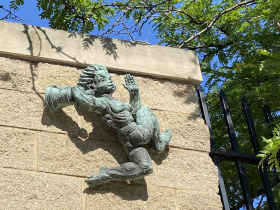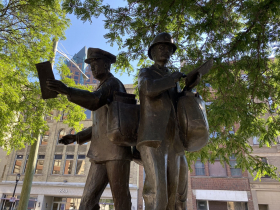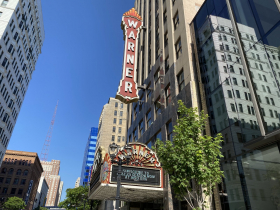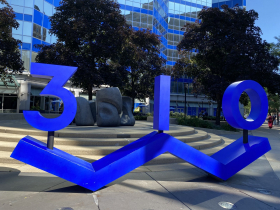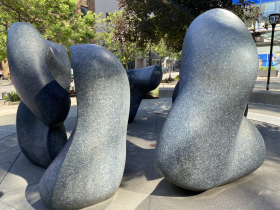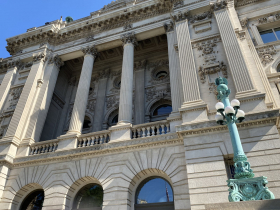Kilbourntown Tour Offers Tons of History
A downtown walk with gargoyles, statues, monuments and more.
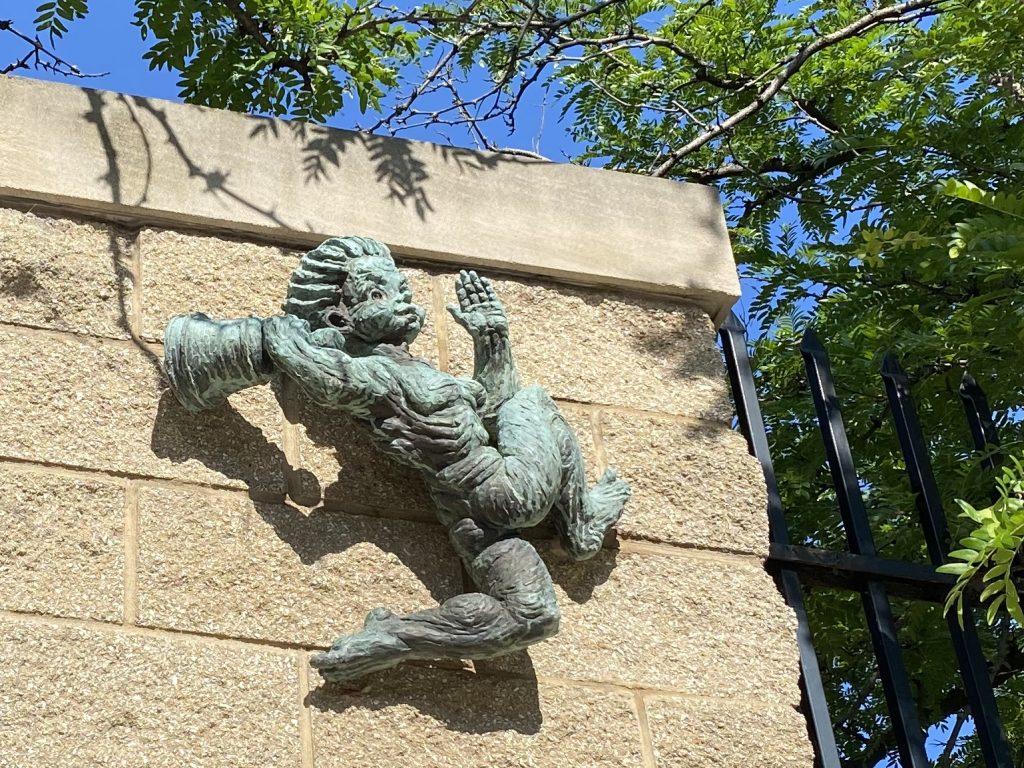
One of the gargoyles at the corner of Kilbourn Ave. and Dr. Martin Luther King Jr. Dr. Photo by Cari Taylor-Carlson.
Distance: Two miles
Start: At the corner of N. Dr. Martin Luther King Jr. Dr. and W. Kilbourn Ave.
Parking: On the street, metered
When Byron Kilbourn, a Yankee from Connecticut, came to Milwaukee in 1835, he wasted no time. He claimed land west of the Milwaukee River, where he planned to build a city. He believed the river would attract commerce to his west side claim, and he would be remembered as the man who founded a great city. At first, it didn’t look like Kilbourn’s land was fit for more than herons and ducks, and certainly not a place to build a city. It was a tamarack and wild rice swamp that continued north to Chestnut Street, now Juneau Ave., and west to N. 9th Street. Above the swamp that ended at Chestnut was a maple-beech forest This is where Kilbourn built his first home. At the same time, Juneautown, east of the river where Solomon Juneau settled, had the advantage of solid ground. Another settler, George Walker, claimed land south of Wisconsin Ave., the third in the trio of Milwaukee founders.
Intense rivalry developed between Juneautown and Kilbourntown. It escalated until 1845, when settlers on the west side of the river destroyed the footings for a bridge that Juneautown residents had constructed to cross the river at Chestnut Street.
This set off The Great Bridge War that ended in 1846 when Byron Kilbourn, Solomon Juneau, and George Walker, compromised and Milwaukee became one community and was incorporated in 1846.
After The Great Bridge War, Kilbourn platted his streets west of the river independent of the streets east of the river. This explains why the downtown bridges that join east and west cross at angles.
As Robert W. Wells wrote in This is Milwaukee, “For a long time, however, the city’s streets changed their names at the water’s edge. And in the old parts of the city, east side and west side streets were not directly opposite each other. The bridges are built at an angle, a reminder to modern motorists of a time when Milwaukee was engaged in a bloodless civil war over whether a resident should be able to go from one part of town to another without using a boat.”
Eventually Kilbourn imported massive quantities of fill, and gradually the west side began to develop an identity and a population that rivaled the number of settlers east of the river.
W. Wisconsin Ave., or Spring Street in Kilbourntown, was a dirt road that got its name from natural springs in the area. As early settlers began to build elegant mansions, Spring Street became a desirable address for wealthy residents. In 1876, it was renamed Grand Avenue. That lasted until 1926, when there was another compromise between east and west, and today we know it as Wisconsin Avenue on both sides of the river. At the same time, Chestnut Street was renamed Juneau Ave. when the city decided to honor Solomon Juneau, the man who is remembered as Milwaukee’s founder.
The Walk
Park close to the corner of W. Kilbourn Ave. and N. Dr. Martin Luther King Jr. Dr. and look for the gargoyles on the northwest corner. They represent a musician, a town crier, a photographer, a printer, a writer, and a telephone operator. They are a reminder of a time when newspapers were produced, before electronic communications and the internet.
Walk east on Kilbourn, turn right on N. Plankinton Ave. and angle right or south on N. 2nd Street to see the Letter Carriers’ Monument. There are three letter carriers, three trees, and three points of a triangle that together make up this tiny parklet in the middle of downtown Milwaukee.
Continue on 2nd Street to Wisconsin Avenue and turn right. At 310, you will come to the Henry Reuss Federal Building and the abstract sculpture Family. Artist Helaine Blumenfeld personally selected 68 tons of granite to be transported to her studio in Carrara, Italy, where she and four assistants worked on the final piece which weighs 38 tons.
Across the street, the former Shops of Grand Avenue once housed 150 businesses and restaurants. Today it’s the 3rd Street Market Hall where you can get a drink, play a game or two, relax on one of the many couches, and, if you’re hungry, there’s food. You can order a burger at Dairyland, a taco at Kompali, an arepa at Anytime Arepa, or enjoy comfort food at Hot Dish Pantry.
Further west on Wisconsin, look for the former Warner Grand Theatre, a restored art deco movie palace, now the home of the Milwaukee Symphony Orchestra.
Next you will come to the Milwaukee Public Library Central Branch, a magnificent limestone building constructed in a combination of French and Italian styles. Climb the steps and enter to see the mosaic tile floor done by Italian craftsmen who lived in Milwaukee. They used unusually small tiles to create an intricate design.
Past the library, you will come to four sculptures known as the Court of Honor. The first is a bronze representation of George Washington. The second is a soldier holding a rifle to commemorate those who fought in the war with Spain. The third piece is a 65-foot column in honor of a carnival held on this site from 1898-1901, and the last piece is an 1898 Civil War grouping of four soldiers titled The Victorious Charge.
Between N. 9th and N. 10th streets, the elegant and private Wisconsin Club is part of the original residence of early settler Alexander Mitchell, once considered Wisconsin’s wealthiest man. It began as a small house on a small lot and grew in stages until it became the imposing mansion we see today. The eight-sided gazebo was built by an Italian woodcarver to give Mitchell a place to view his gardens.
Turn right or north on 10th Street and continue to W. Wells St. At the Milwaukee County Courthouse look for Solidarity/The Spirit of Polonia. It was commissioned by the Polish Women’s Cultural Club in honor of Polanki, the radical Polish trade union movement.
Current street construction makes the route back a bit complicated. Continue on Wells to 9th and turn right. Turn left on Wisconsin Ave. and left again on 6th. Follow 6th to State St., turn right and continue to Dr. Martin Luther King Jr. Dr. Turn right, walk one block to Kilbourn, and you are back where you started.
Byron Kilbourn would be proud of his settlement, once a swamp, now a thriving part of Milwaukee, constantly evolving and uniquely different from Juneau’s settlement on the other side of the river.
Along the Walk
If you think stories like this are important, become a member of Urban Milwaukee and help support real, independent journalism. Plus you get some cool added benefits.
Milwaukee Walks
-
Riverwest Is a Melting Pot
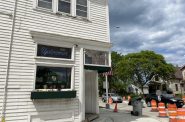 Aug 25th, 2023 by Cari Taylor-Carlson
Aug 25th, 2023 by Cari Taylor-Carlson
-
Layton Boulevard Has Overlooked History
 Jul 23rd, 2023 by Cari Taylor-Carlson
Jul 23rd, 2023 by Cari Taylor-Carlson
-
Washington Park Was Once Farmland
 Jul 7th, 2023 by Cari Taylor-Carlson
Jul 7th, 2023 by Cari Taylor-Carlson


